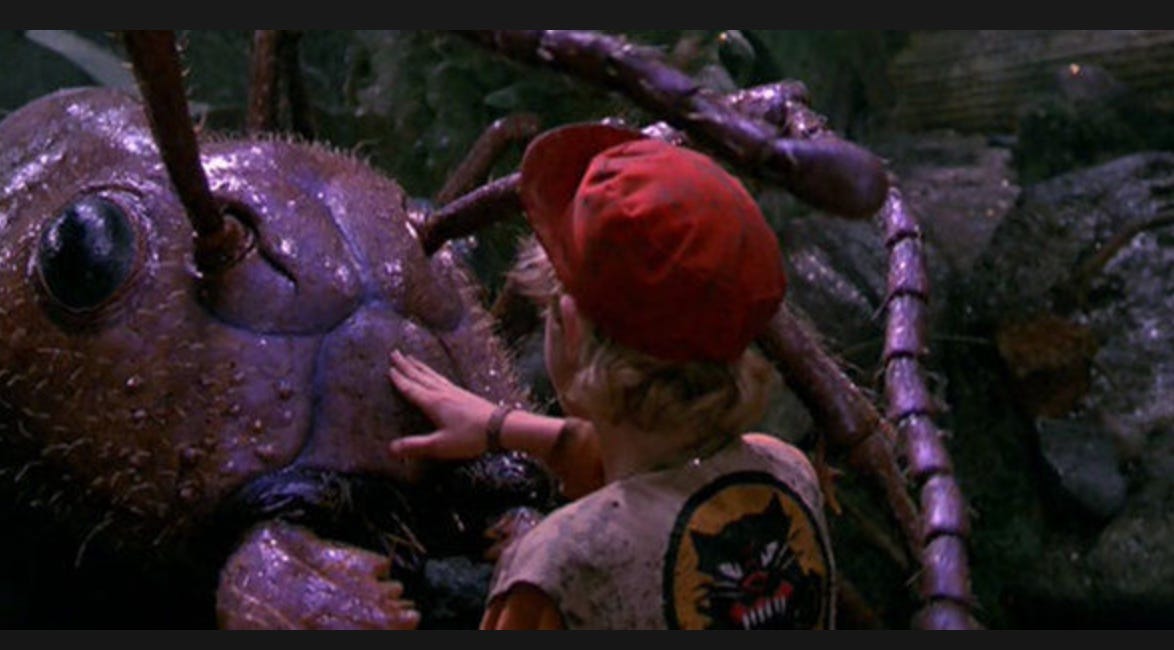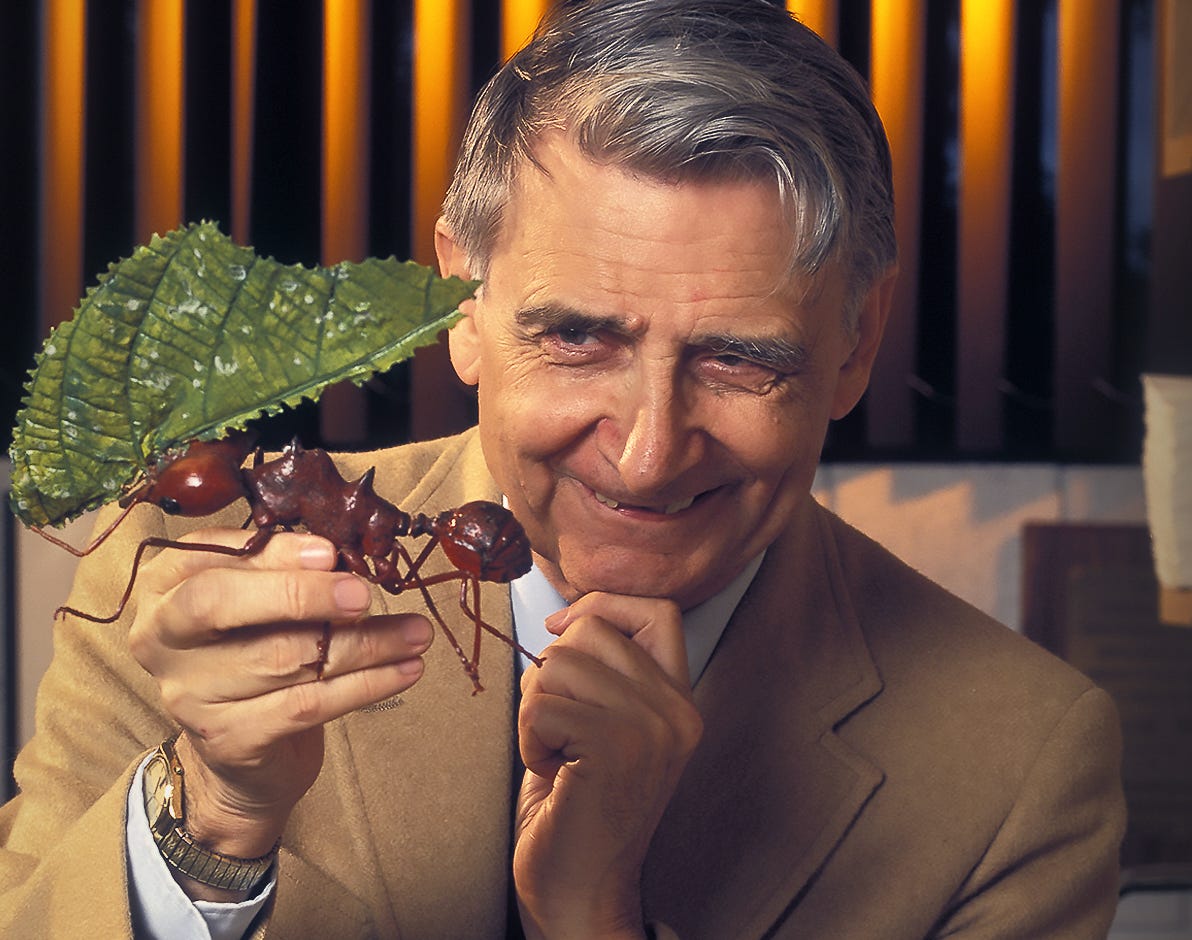Raise your hand if you love six-legged socialites.
Ants are social creatures who communicate a lot. Sometimes ants are even social enough to communicate with us humans.
Yes, I did work hard to give myself a segue to talk about the masterpiece movie, Honey, I Shrunk the Kids. For those not in the know, this movie’s scene stealer was the lovable baby ant, Antie, who played the hero to four shrunken kids lost in a backyard.
Hollywood loves bugs. Or else, they love that kids love them and drag their parents to see movies about them. From Antie’s poignant role in Honey I Shrunk the Kids, 1 to full-length features like A Bug’s Life, and Bee Movie, bugs are brought to life, sparking the interest of future entomologists (bug scientists) worldwide.
But among all the entomologists who fell in love with bugs when they were little grubs, maybe the most influential was E.O. Wilson.
Wilson had a tumultuous early childhood, witnessing the mental health problems and divorce of his parents and moving around a lot. He found solace in nature, falling in love with bugs and distinguishing himself early in his academic career as an expert in them. Wilson even founded an entirely new field of research: Sociobiology (this is the biological study of social behavior).2
One of the core social behaviors of animals? That’s right, communication. And Wilson helped us learn a lot about ant communication. What Wilson learned offers some powerful insights about our own communication pitfalls and perks.
Ants are adept communicators.
Like humans, ants live in large communities that must collaborate and keep one another in check to survive and reproduce their genetics. And like humans, ants communicate to accomplish these goals.
Of course, ants don’t generate language the same way humans do. They don’t say words because they have no tongue or vocal cords. And then there’s the fact that ant brains aren’t built to decode words.
No matter, ants have their own nifty approach to exchange important information. They communicate through chemical compounds. That is, they chat by odor.
As Wilson writes,
Among all the organisms that live by smell and taste, ants are the virtuosos of chemical communication.
The odors each ant’s body exudes carry messages to other ants in the colony and inform them about topics like their gender, age, and role in the community. Odor-based messages also offer important information about the presence of intruders, or whether food is available and where it can be found.
Specialized to receive information via odor, ants interpret it in seconds and with incredible precision. That’s a critical feature of ant communication because efficiency and accuracy are necessary for ant colonies to survive.
Wilson explains a specific feature of this communication by odor strategy that prevents ants from misunderstanding one another:
Humans communicate by sight and sound, allowing the creation of words with arbitrarily chosen meanings. In other words, we communicate by language, the prerequisite for the most rapid possible evolution of social order. Ants, in contrast, use chemical secretions smelled or tasted with gene-fixed meanings.
For ants, there is no misunderstanding the meaning of a message because there is only one meaning for a given message. Imagine if human communication worked like that. No second-guessing texts, no reading between the lines, no wondering if “I’m fine” actually means “I’m furious.”
The ambiguity of language and the assumptions, emotions, and interpretations in every human interaction means that we humans often hear things that weren’t said or say things that aren’t heard. In my work as a couples therapist, I see this all the time—partners assume they’re being crystal clear, but what they mean and what the other person understands are often wildly different.
Ants never have that problem. Communication by odor, where odors have fixed meanings, means ants don’t need to fear misunderstanding one another.
E.O. Wilson’s sense of humor sheds yet more wisdom on understanding.
E.O. Wilson had some fun in his communications with ants, too. In his book, Tales from the Ant World, he explains that ant colonies often have a cemetery chamber in the nest to which ant corpses are brought. Wilson realized that dead ants were being distinguished from live ones by odor and that there must be some kind of chemical signal that initiated the dead ant being brought to the cemetery.
Wilson set himself to the task of identifying the chemical signature of a dead ant. Then, he tested his findings by putting the chemical on dead ant “dummies” (wood flecks about the size of worker ants). Sure enough, when the drops of the bioassay were placed on the wood flecks, ants in the colony would bring the wood to the dead ant pile. The experiment worked.
And then, Wilson wondered: “What would happen if I daubed a live, healthy worker with one of the funereal substances?”3 When he tried it out, he found:
Worker ants that met their daubed nestmates picked them up, carried them alive and kicking to the cemetery, dropped them there, and left.
This foray into Wilson’s Frankenstein-style laboratory may seem random, but there’s an important take-home message here. While ants never have to wonder, “Why didn’t they understand what I meant?”, the deficit in flexibility in understanding means new learning about the meaning of a message is not possible. A live ant with a dead smell will inevitably find themself being carried, even alive and kicking, to the little ant cemetery.
Simple, straightforward communication has its perks. But multiple meanings also has some perks, even if it does mean we have to wonder whether we are interpreting messages correctly.
For one thing, we humans are more likely than our ant friends to think twice before carrying someone who tells us “I’m dead” to the morgue.
From understanding ants to understanding humans.
Ants and humans are similar in that we both rely on communication to protect our species and help our societies thrive. But Wilson helped us appreciate the beauty of ants’ straightforward approach to understanding one another. With less wiggle room about communication, there is less uncertainty about how to interpret a message.
We can appreciate the benefits of straightforward ant communication. And we can also grow our gratitude for our more complicated, misunderstanding-prone human communication.
Unrelated to Ants…
I’m now firmly back in my co-host seat at the Psychologists Off the Clock podcast and excited to report that the podcast is nearing its 400th episode! If you’re curious about the process of podcasting, this will be the topic of episode 400 and we are collecting questions. You can leave questions by commenting here (or email them to me).
- is out with a brand new edition of her incredible book, How to Break Up with Your Phone. In honor of the release of the book, she’ll be running a "February Phone Breakup Challenge" on her "How to Feel Alive" Substack for readers who want to go through the book's four-week plan together. Paid subscribers will have access to a private "Phone Breakup Support Group" Substack chat where they can ask questions, share experiences, and get advice. Join the breakup challenge by heading to her Substack!
Speaking of movies… Is anyone else experiencing ongoing frustration in locating movies that kids who range from elementary school through high school won’t hate? It feels like a riddle I can’t solve (though Honey I Shrunk the Kids actually did fit the bill!). And if you cracked the code, please share in the comments!
I read this newsletter to my eight-year-old, who told me, “There’s too many words I don’t know in here!”
That E.O. Wilson created ant zombies makes me think he would have been the most fun dinner guest ever.







This was delightful and now I know some ant trivia to impress my kids!
This is a super cool post, Yael! I’ve decided to leave humanity and join the world of ants :)